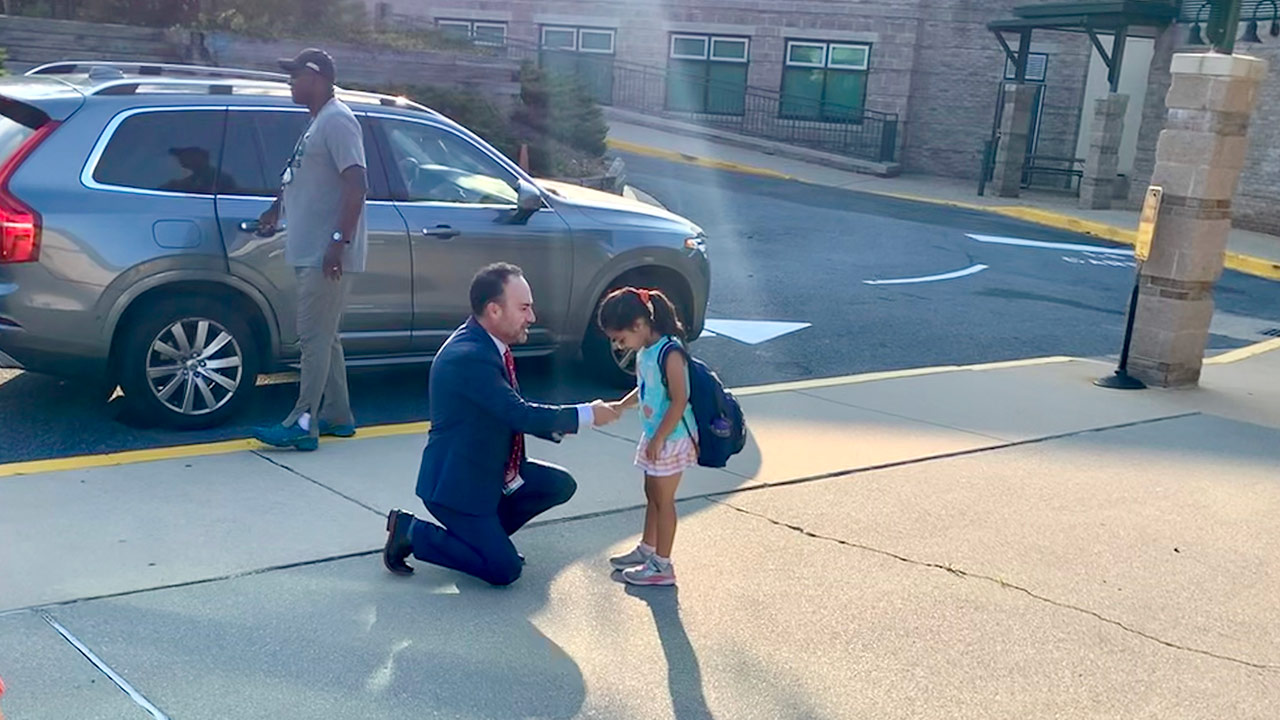This morning during carpool, I opened the door of a minivan to find a pre-K student clinging to his car seat. His mom looked back from the driver’s seat with a worried expression. The four-year-old gazed at me through burgeoning tears. He appeared to be having second thoughts about school.
After some gentle coaxing, he climbed down from the car and we stood together on the sidewalk preparing to walk into the building. “How long is this one?” he asked me.
“How long is what?” I responded.
“This day. How long is it? I mean…how many hours?”
While he could have been probing quantum physics and the space-time continuum, I guessed that his question was far more straight-forward. How long would he be at school? And could he possibly tolerate that many hours in a row? Together as we walked down to his classroom, I asked him to tell me about the different activities that he does at school during the day. By the time we got to snack, we had arrived at the classroom. He hugged his teacher “hello” and ran off to join friends.
It’s not unusual for transitions to be bumpy. As humans, we crave routine. When our routines are upended, it knocks us off balance and leaves us feeling anxious and vulnerable. It’s for this reason that the first weeks of school are all about establishing routines. It’s easy to mistake this part of the school year as a waste of time. “When are they going to start learning?” we want to ask. And yet internalizing a new routine is learning—it requires both mental and emotional energy to adjust to new surroundings, new activities, new people. This is why both children and adults report feeling exhausted at the start of a new school year even though “we didn’t do anything.” And this is why the aforementioned pre-K student was having second thoughts about leaving the car. He wasn’t sure if he had the energy to step into the new world of school yet again, exerting the considerable effort needed to make the unfamiliar become familiar.
During our opening faculty meetings in August, our four high school grade deans presented to the high school faculty on some of their learning from a weeklong workshop at the Stanley King Counseling Institute. The institute specializes in developing the capacity of independent school educators to foster a positive, healthy environment for young people. The focus of the deans’ presentation was on the difference between “fixing” and “deep listening.” It turns out that this framework isn’t just useful for educators—it’s also vital for parents.
As parents, evolution has conditioned us to solve problems for our children. We can’t stand watching our kids struggle, and we feel an overpowering urge to remove obstacles from their paths, obstacles that feel overwhelming to them but are easily navigable by us. It’s this urge that has led to pop culture mythology around pushy parenting styles, including the “helicopter parent” who flies in to rescue a child in crisis and the “snowplow parent” who flattens any obstacle in their child’s way.
When our child comes home with a problem, be it homework that is confusing or a classmate who isn’t being kind, our first instinct is often to offer up a solution. As adults, we know how to solve problems. Why should we let our children suffer when we have the capacity to intervene and make things better?
It turns out that in solving some problems for our children, we often create others. A child who is used to having problems solved by a teacher or parent can quickly grow dependent on this help. They may begin to think they lack the capacity to create their own solutions, and they don’t learn to tolerate the discomfort that comes along with struggling.
As parents and educators, we need to learn to substitute our impulse to fix problems with the patience to listen deeply without offering solutions. Whereas fixing focuses on quelling or containing emotions, deep listening allows emotions to be present and simply acknowledges them. Fixing seeks quick results. Deep listening accepts a lack of resolution.
Here’s an example: A child comes home feeling overwhelmed by school and frustrated that he is doing “all of the work” for the big group project that is due next week. His parent is ready with an array of next steps: “Why don’t you assign the other group members what they each have to do?” “You should put your name next to all of the parts that you did so that the teacher gives you credit.” “I’m going to send an email to the teacher so she knows that you’re doing all of the work.” These “fixes” may address symptoms, but fail to get at the underlying issue. Sometimes what a child needs is simply to be acknowledged: “Wow, that sounds like a lot.” “I can tell you are working really hard.” “Do you have ideas about what you want to do?”
When we listen to our children without solving their problems, we are recognizing that like adults, children sometimes just need to be heard. When we are patient and let children develop their own solutions to challenges, we are building their capacity to address future problems and developing their resilience in the face of setbacks. In can be frustrating to watch our kids stumble, especially when we are sure we have a better solution to their problem than the one that they’ve come up with. And yet just as we need to let our toddlers take their first steps, fall, and get back up, so we need to let our children develop their problem-solving muscles. Parenting demands that we take the long view. The small and ultimately inconsequential challenges we allow our children to struggle with today will lead to a resilient young adult able to handle the tougher challenges that will surely come their way.


